Peter McLeish – Art, Science, Space and an Atmospheric Phenomenon Named Red Sprites – 2004
Artist – Dr. Walter A. Lyons -Sky-Fire Productions Inc. USA
First publication workshop Space: Science, Technology and the Arts in collaboration with ESA/ESTEC, 2004
What are red sprites?
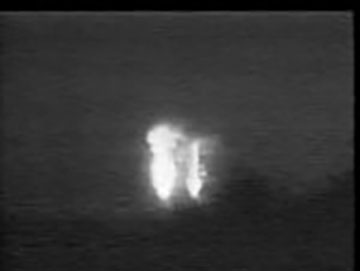
Red sprites are upper atmospheric optical phenomenon associated with thunderstorms that have been recently documented using low level television as well as other instruments. The first images of a sprite were taken in 1989 (Franz,R.C., R.J. Nemzek, and J.R. Winckler,- Television image of a large upward electrical discharge above a thunderstorm system, Science, 249 48-51,1990) and from 1990 to 1994 the space shuttle obtained twenty more images.
Inspired by these initial findings, two independent field programs were created and focused their research on this new phenomenon. Davis Sentman of the University of Alaska Fairbanks (UAF) sought to record the flashes from an aircraft flying over the Great Plains in the summer of 1993 [1]. That same summer, playing on a hunch Walter A. Lyons of FMA Research set up detectors on Yucca Ridge in the foothills of the Rocky Mountains [2]. Within a day of each other, these two research teams had documented what turned out to be a common phenomenon in the mesosphere. It was during this process, that they initiated a new kind of continental-scale field experiment and more importantly a new interdisciplinary area of research [3]. Sentman and Lyons found two broad classes of flash: sprites (named by Sentman) and elves (named by Lyons).
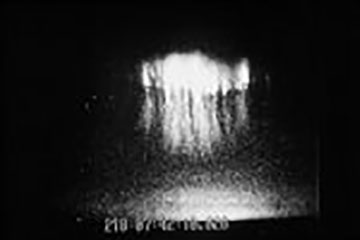
Despite nearly a century of anecdotal reports from airline pilots, most scientists didn’t really believe in sprites until the first images were captured on high-speed video. Their position and beauty caused « a major frenzy of excitement » among scientists. Numerous images later, sprites remain poorly understood, because they disappear almost as soon as they form. There are a remarkable variety of sprites with different shapes and forms. These varieties of sprites are as different and original in shape and form as each snowflake. The blink of an eye last 250 milliseconds: sprites often last only ten. Cameras and computer models freeze sprites in time. It’s possible to see sprites with the naked eye. If you are in a rural area, and let your eyes become dark adapted, look above the area where large thunderstorms are occurring 100 to 300 miles away.
The Color of Sprites
Current thinking is that sprites result when free electrons in the thin atmosphere are accelerated by the sudden change in electric field strength caused by the parent lightning discharge far below. When the electrons slam into molecules of nitrogen, they cause the nitrogen to glow. Certain energies result in primarily red optical emissions, but in the lower part of the sprite, blue colors can also be seen. The process is not all that dissimilar from the aurora, where the energetic particles are supplied by the solar wind. Oxygen also is activated in the aurora, accounting in part for the green and white colors that also occur in that phenomenon. Some humans see sprites as white or green in color, but that is a result of the inability of the human eye to distinguish colors at such low intensities.
The Name Sprite
The meaning of the word sprite (n) is
1. in folklore, a small supernatural being like an elf or a fairy, especially one associated with water
2. a small or delicately built person who is likened to an elf or a fairy
3. in folklore, a ghost or spirit
4. an independent graphic object that moves freely across a computer screen
5. a soul (archaic)
When people first began reporting sprites, initially from naked eye observations, and then in 1989 on video tape, no one really knew what to call them. Rocket lightning, “flachenblitz”, upward lightning, cloud-to-stratosphere, and even cloud-to-space lightning were just a few of the names used. This started getting very confusing very fast, especially as no one knew if the phenomenon was actually lightning (as opposed to be being a result of lightning), whether it was connected to the clouds, which way it went, and whether it reached into “space.” Thus, early on, scientists realized that a name was needed that was descriptive of the phenomenon, but did not imply that we understood the physics before we did. « Sprites” are mythical, fleeting, and playful creatures that appear in mythology and Shakespearean plays. The name was first suggested by Prof. David Sentman of the University of Alaska-Fairbanks in 1994, and it stuck. As new transient luminous events (TLEs) above thunderstorms were discovered, they were given names in the same vein: elves, trolls, gnomes, pixies and blue jets (which just named themselves because they looked just like…blue jets.)
Types of Sprites
The most elemental, and likely smallest, sprites are single vertical columns named C sprites. Large collections of C sprites resemble Fourth of July fireworks. A subset of the sprites with tendrils–often the largest and most energetic–also exhibit upward branching toward the ionosphere, and are named carrots. Very large sprites with diffuse tops and lower tendrils extending down to altitudes of 30-40 km have been dubbed angels, jellyfish, and A-bombs. With maximum vertical extents exceeding 60 km, these giant sprites extend vertically three times farther than the largest thunderstorms. Other sprite types are angel sprites & broccoli sprites.
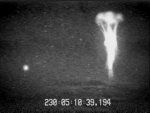
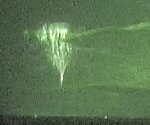
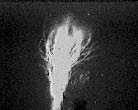
Transient Luminous Events
Red sprites, Blue jets and Elves are three principal types of upper atmospheric optical phenomena which are collectively known by atmospheric physicists as Transient Luminous Events (TLEs).
Blue jets are a second upper atmospheric optical phenomenon, distinct from sprites, observed above thunderstorms using low light television systems. Blue jets have been reported in anecdotal accounts over the last century. As their name implies, blue jets are cone-shaped, dim blue lights-which appear as optical ejections from the top of the electrically active core regions of thunderstorms. The first images were captured by University of Alaska scientists onboard a NASA research jet in 1994, initially using a very wide angle low-light, black-and-white television camera flying over eastern Arkansas. Cameras and computer models also freeze Blue jets in time. Following their emergence from the top of the thundercloud, they typically propagate upward in narrow cones of about 15 degrees full width at vertical speeds of roughly 100 km/s (Mach 300), fanning out and disappearing like a quick puff of smoke at heights of around 45 km with a lifetime of a couple of tenths of a second. Blue jets are not aligned with the local magnetic field.
Elves are a third upper atmospheric optical phenomenon which appear as flat disk-shaped regions of dim luminosity at around 100 km in altitude and rapidly expand up to 480 km across. They are extremely brief, lasting less than a thousandth of a second and occur high above energetic cloud-to-ground lightning of positive or negative polarity. Sometimes they can be accompanied by Red sprites, but usually not, as the causative mechanism is of an entirely different nature. Elves form when large lightning bolts send a strong electromagnetic pulse into the ionosphere, shaking up the electrons in nitrogen gas so strongly that they emit light by fluorescence. Predicted to exist in 1991 and discovered with a low-light video camera aboard the Space Shuttle in 1992, elves got their name as an acronym for Emission of Light and Very Low Frequency perturbations due to EMP Sources.
Lightning's Angels
I am a Canadian artist, who specializes in paintings and multi-media events which highlight the beauty of science. I have a Masters of Fine Arts (University of Guelph, Ontario). My interpretation of sprites as art, are presented in my video titled Lightning’s Angels and is being prepared for museum and gallery presentations around the world. My selected suite of sprites is displayed below in thumbnail version and are views seen from up above and/or from an aircraft. Lightning’s Angels is a six-minute video that combines digitally enhanced oil paintings of a Sprite, in various states of transformation accompanied by the song MISERERE from the cd STATE OF GRACE by Paul Schwartz featuring the Joyful Company of Singers. I believe it is important to promote unity, between art and science in order to create a better understanding of the natural world. My project is with the cooperation & assistance from American scientist Dr. Walter A. Lyons: FMA Research Inc. – www.sky-fire.tv & scientist Dr. Colin Price from the Department of Geophysics and Planetary Science, Tel Aviv University.
Their Science, My Art
With the unexpected discovery of Red sprites, atmospheric physicists began proposing, and disposing
of scientific theories in order to explain this phenomenon. It soon became clear, that sprites occurred only above rare positive cloud to-ground lightning flashes which were usually 10% of a storm’s total. A theory proposed in 1925 by Nobel Prize winning the Scottish physicist C.T.R Wilson, predicted the existence of brief flashes of light high above large thunderstorms. This theory predicted that electric fields can cause ionization at great heights and could therefore give rise to discharges between clouds and the upper atmosphere [4]. In 1956 Wilson commented, “It is quite possible that a discharge between the top of the cloud and the ionosphere is a normal accompaniment of a lightning discharge to earth…a diffuse discharge between the top of the cloud and the upper atmosphere…many years ago I observed what appeared to be discharges of this kind from a thundercloud below the horizon. They were diffuse, fan-shaped flashes…extending up into a clear sky.” C.T.R. Wilson suggested that when massive amounts of electrical charge were lowered to ground, the event would briefly upset the electrical balance of the middle atmosphere, causing a “spark.” These observations demonstrated that this spark occurred approximately at 45 miles altitude, followed by a burst of upward and downward propagating electrical streamers [5].
In order for Wilson’s theory to be correct, the lightning involved had to be massive, larger than what textbooks had claimed. So, with this in mind, during the summer of 2000, an NSF sponsored program called the Severe Thunderstorm Electrification and Precipitation Experiment (STEPS), did find that such powerful lightning bolts dwell in the huge thunderstorms roaming the central U.S. on summer nights [6].
Scientist, Walter A. Lyons uses this theory in his understanding of sprites. I also employ this theory to form a better understanding of sprites as well as create a new visual reference. The more scientific information I know about sprites the better I can create a visual reference for it. For instance, my paintings titled Start of a Sprite concentrates on the initial electrical charge of a sprite and scientific theories can help me demonstrate a further understanding of a sprite in order to create a new visual reference. Scientific video & photography equipment continues to be further developed & upgraded in order to better research the new information about sprites. I feel that science helps me learn from nature and this inspires my work.
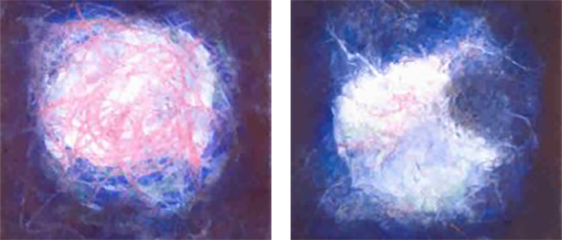
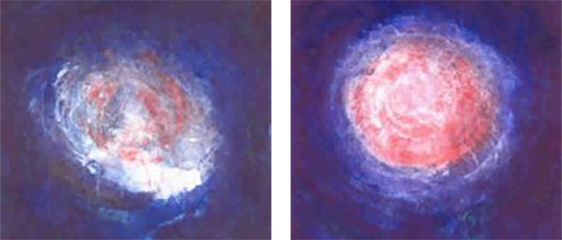
Azimuthal Symmetry
Azimuthal symmetry (or asymmetry) is very simple. Azimuth means angle (azimuthal = angular) and symmetry in regards to sprites, means basically each side of the phenomenon is the mirror image of the other.
So, azimuthal symmetry (AS) simply means that the phenomenon (sprites) show the same form, brightness, shape, color, etc. no matter what direction you look. Now depending on where you are looking from, the phenomenon may or may not have azimuthal symmetry. For example, if you are sitting in the middle of a sprite looking outwards, then I would expect you to observe AS, i.e. the same view in all directions (360 degrees). An example of AS with regards to my work, could found in my series titled Inner Sprites. I hypothesize that my series titled Inner Sprites, would be the views of a person sitting in the middle of a sprite, looking outwards in all directions (360 degrees).
But looking downwards would give a different view from looking upwards (from the middle). However, from the side, the sprite may be brighter in the middle and have different features in the middle and at the edges (hence azimuthal asymmetry).

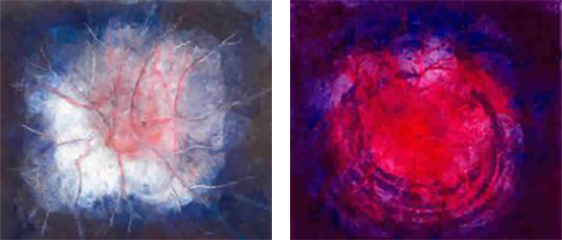
The history of my art & science
The Glory Project 1998-2000 Planetarium de Montreal
A Glory is a circular rainbow formed on top of clouds. The Glory Project is- I projected digitally enhanced slides of my paintings of a cloud Glory on the 20 meter dome ceiling of the Star Theatre in the Planetarium de Montreal. Slides of thirteen works were projected, creating a Glory in transformation. Each slide dissolves into the next slide. The audience was enveloped in sound while the slides were projected. The soundtrack was the song « Ave Maria » composed by Giulio Caccini (1550-1618) as performed on the album (1998) by popular contemporary singer Vyatcheslav Kagan-Paley (courtesy of Victor Entertainment Inc. Japan). The Glory Project was a combination of art, entertainment, science and education. This project was advertised on the SPACE (a Canadian television network dedicated to Science) and attracted T.V. news and newspaper attention.
Some of the influences and inspiration for the Glory Project come from the writings, philosophies and / or works of Richard Wagner’s theory of Gesamtkunstwerk (the total work of art), Otto Runge’s unfinished work Morning(1809), Gustave Mie (Mie Theory), the concept of The Trinity of Man as espoused by G.I Gurdjieff , P.D. Ouspensky and H.P. Blavatsky.

In the Beginning
In 2001, after completing & exhibiting of my previous art & science titled The Glory Project, I continued my research on natural phenomena and found a new discovery called Sprites. It was during this research that I noticed that there was a scientist named Walter A. Lyons who had been working on a new natural phenomena. I contacted Walter with this idea for a sprite project in the winter of 2001 and after two months corresponding, we decided to start collaborating. In May 2001, I sent Walter a copy of my proposal in with his application to the United States National Science Foundation (NSF) in Washington D.C. In 2002 Walter has informed me that this application was successful and he has received approval from the U.S. National Science Foundation (NSF) to fund the sub-set to any of my sprite exhibits. This specially designed sub-set titled The Hundred Year Hunt for Red Sprites is an interactive website & DVD on sprites and other aspects of the « Electrical Earth ».
-The scientist: Walter A. Lyons & Yucca Ridge Field Station, FMA Research Inc. is and has been funded by NASA and the U.S. National Science Foundation. Walter A. Lyons, Ph.D., President of FMA Research is a Certified Consulting Meteorologist, Member of the U.S. National Council of Industrial Meteorologists, AMS Radio and TV Seals of Approval, Fellow of the American Meteorological Society, Ph.D. University of Chicago (1970).
In addition to my collaboration with scientist Walter Lyons: FMA Research, I have joined forces with scientist Colin Price professor from the Department of Geophysics & Planetary Science: Tele Aviv University who has a research station in Israel Colin was on sabbatical from September 2001 to August 2002 at the Canadian Meteorological Services : Meteorological Research Branch.
Sprites and the space shuttle tragedy
Meidex
The Mediterranean Israeli Dust Experiment (MEIDEX) was performed on-board the space shuttle Columbia during its last mission in January 2003. During 25 orbits there were observations toward the Earth’s limb above forecasted areas of active thunderstorms, in an effort to image Transient Luminous Events (TLEs) from space. The astronauts used a Xybion IMC-201 image-intensified camera and performed continuous recordings of the atmosphere from the direction of the night side toward the dusk terminator. Simultaneously with the optical observations from space, dedicated ground measurements in the ELF/VLF frequency range were conducted at several stations around the world. The obtained calibrated video data were analyzed during the mission and showed the occurrence of many TLEs over oceanic and continental storms [7].
As part of my art & science project I had added scientist Dr. Colin Price from the University of Tel Aviv- Israel as one of my scientific advisors on my sprite project. Colin was working from a ground research station on a mission called Meidex, from the Space Shuttle Columbia. Ilan Ramon (who died on the space shuttle Columbia) a Colonel in the Israeli air force, was working on this mission called Meidex for Israeli Government. A major part of the Meidex mission was to take pictures, research data and experiments of dust storms and (if possible) also sprites. Several months ago, I was informed that Ilan Ramon did (transmit and) take some wonderful pictures (and data) of sprites on this last mission. Ten months before this tragic accident, I had previously mentioned this Meidex mission as part of my on going research on sprites. There were other several important experiments done on this mission. I did not personally know Ilan Ramon but of course Colin did. I am very sadden and stunned by the loss of Ilan Ramon and all the other astronauts whom died on the Space Shuttle Columbia. I have since sent my condolences. A very sad day for everyone…
Shortly after the tragic loss of the Shuttle Columbia on 1 February 2003, wild rumors began to fly that the Shuttle was brought down by a sprite. This was fueled by reports of a picture taken by an amateur astronomer in San Francisco purporting to show some sort of “lightning-like bolt” striking or emanating from the orbiter as it flew over the California coastline. As of this writing, NASA has not released the image for external scientific review. But neither the description of the image nor the weather conditions at the time suggested that a classic sprite could have been involved. If the image does not turn out to be simply an optical illusion, then the possibility of some as yet unknown electrical phenomenon at the base of the ionosphere will have to be investigated.
Hopes for the futur
I hope that my art & science collaboration will inspire the imagination of many, and ignite an interest in contemporary art that is influenced (and/or inspired) by science. I also hope to raise public awareness of sprites as well as promote my project in a dialogue between art & science with in a range of arts, science and public venues in order to reach a new & wide international audience. I also intend to raise public interest in contemporary art, science & nature by exploring new forms of creative expression, and to increase communication and collaborations between these fields.
References
[1] W. A. Lyons, Geophys. Res. Lett. 21, 875 (1994).
[2] D. D. Sentman, E. M. Wescott, Geophys. Res. Lett. 20, 2857 (1993).
[3] C. J. Rodger, Rev. Geophys. 37, 317 (1999).
[4] C. T. R. Wilson, Proc. Phys. Soc. London 37, 32D (1925).
[5] W. A. Lyons, R.A. Armstrong, E. A. Bering, III, and E. R. Williams, The Hundred Year Hunt for the Sprite, EOS, Trans. AGU, 2 (2000).
[6] Timothy J. Lang1, L. Jay Miller, Morris Weisman, Steven A. Rutledge1, Llyle J. Barker, III,
V. N. Bringi1, V. Chandrasekar1, Andrew Detwiler, Nolan Doesken, John Helsdon, Charles Knight, Paul Krehbiel, Walter A. Lyons, CCM, Don MacGorman, Erik Rasmussen, William Rison, W. David Rust, Ronald J. Thomas, The Severe Thunderstorm Electrification and Precipitation Study (STEPS),Revised-edition, U.S. (2004).
[7] Y. Yair, C. Price, Z. Levin, J. Jospeh, A. Devir, B. Ziv1, M. Moalem, P. Israelevich, and S. Clodman
Coordinated Observations of Sprites and Other TLE from the Space Shuttle During the Meidex,
Proceedings of the XII ICAE meeting,France,1 (2003).
Some of the general science reference for this paper is courtesy of Dr. Walter A. Lyons -Sky-Fire Productions Inc.
My participation at the 7th Workshop on Space and the Arts is undertaken with the assistance of the Canadian Embassy, The Hague/Avec l’aide de l’ Ambassade du Canada, La Haye and The Canada Council for the Arts.

© Peter McLEISH & Leonardo/Olats, mai 2004, republished 2023
Leonardo/Olats
Observatoire Leonardo des Arts et des Techno-Sciences
À propos / About | Lettre d'information Olats News



Pour toute (re)publication, merci de contacter / For any (re)publication, please contact Annick Bureaud: info@olats.org
Pour toute question concernant le site, merci de contacter / For any issue about the website, please contact: webmaster@olats.org
Design Thierry Fournier
© Association Leonardo 1997-2022